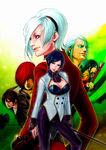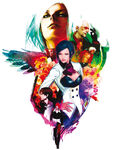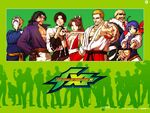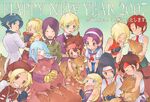No edit summary Tag: Source edit |
No edit summary Tag: Source edit |
||
| Line 1: | Line 1: | ||
| − | {{GameNavigationInfobox|SNK|The King of Fighters XI|y |
+ | {{GameNavigationInfobox|SNK|The King of Fighters XI|y|y||y|y|y}} |
Revision as of 23:00, 21 April 2021
| The King of Fighters XI | Team Stories | Stories | Move List | Gallery | Soundtrack |
11 teams have been assembled... Only one will survive!
-Arcade Tagline
The King of Fighters XI (ザ・キング・オブ・ファイターズ イレブン; Za Kingu obu Faitāzu Irebun; KOF XI) is the eleventh installment of The King of Fighters series. This game continues the "Tales of Ash" story arc, started in The King of Fighters 2003.
Its tentative title was "The King of Fighters 2004" though this name was debunked by the end of 2004.[1] The numerical distinction for the series is based primarily on SNK Playmore wanting to avoid being locked into a rigorous yearly schedule of releases.
Story
Mukai, a member of a mysterious group, stole the Orochi seal in the last tournament and broke it, causing confusion and destruction to happen from within sight. Taking advantage of the situation at hand, Ash stole the Yata Mirror from Chizuru and drained her powers in the process. In the advent of a new KOF tournament, new faces are handed invitations, while old faces, such as Eiji Kisaragi, return to the ring. Among the new KOF participants are Oswald, Duck King (a South Town veteran fighter himself), Momoko, and Elisabeth. All these fighters will find themselves in a tournament full of mysteries and secrets started by motives that they’d ignored. Behind this healthy competitive tournament hides a hidden force called "People from the Past" with a mysterious goal.
Game Mechanics
Aside from the already known gameplay maneuvers that add much depth to the gameplay, Runs, Rolls, Short Jumps, Guard Cancel CDs and Rolls, Empty Cancels, and the returning Quick Emergency Roll, the four largest innovations KOF XI brings to the franchise are the Quick Shift, the Saving Shift, the Skill Gauge and the Dream Cancel.
The Skill Stocks significantly complicate the gameplay of KOF. The Power Stocks that existed previously are still present, and are filled in the usual fashion. Nevertheless, there are now Skill Stocks as well, which gradually build up over time. Each team begins a match holding the maximum of two Skill Stocks. Offensive maneuvers, such as Desperation Moves, Guard Cancels, and Tag Attacks, continue to use Power Stocks. However, more defensive or tactical maneuvers, such as Guard Evasion, Saving Shift, and Quick Shift, use Skill Stocks.
KOF XI utilizes the Tactical Shift System from KOF 2003, but makes very important changes. The Quick Shift allows you to change into another character in the middle of any combo, prolonging it, or in the middle of any attack, no matter if it was blocked or not, canceling the frames of animation of the attack, if it's needed. The Saving Shift allows the player to take out a character when he is being hit as soon as he is hit, or in any moment, at the cost of both skill bars. This effectively cuts many combos that otherwise would do a lot of damage, eliminates the possibility of infinities by repeating chains of attacks on the ground (excluding aerial juggles) and brings an element of balance to the game. While it is possible to escape from any combination of attacks on the ground, it is not possible to use Saving Shift to get out from a Desperation or Leader Desperation move.
The last new feature of KOF XI is the Dream Cancel. Like the Super Cancel that first appeared in KOF '99, Dream Cancel allows players to use stocks to interrupt a move in the midst of its execution with a more powerful move, allowing devastating combos; however, the Dream Cancel is more deadly than ever, allowing a DM to be canceled into an LDM, at the expensive price of two Power Stocks and one Skill Stock.
Should the timer run down in a match, the winner is no longer decided based upon who has the most life remaining. Instead, the judgment bar, a new bar of circular shape composed of two colors, each one representing one player (red or blue, which are the colors displayed in the portraits of the characters of each side) acts as a quantifier of the skill of each player. Whichever player has the judgment bar towards his side will be the victor if none of the teams win defeating all three characters from the opposite team; rarely, if the bar is exactly in the center, the match will end in a draw and both sides will lose. The bar is affected by each attack that the players get in, combos affect progressively more, and when a character of the opposing team is defeated, the bar suffers a big change against that player. This makes taking care of keeping one's characters alive pretty important, giving strategy to the tags system.
Critical Reception
Since the PlayStation 2 was being replaced by a new console during the release of The King of Fighters XI, Gamasutra listed the game as one for the "hardcore gamer". However, in its release week in Japan, The King of Fighters XI was the only PlayStation 2 title to be featured on Japanese sales charts alongside Konami's World Soccer Winning Eleven 10. The number of copies the game sold in Japan throughout 2005 is unknown, although it sold 47,225 units in 2006.
Critical reception to The King of Fighters XI has been "generally favorable" based on an average score of 75 out of 100 on the Metacritic website. The quality of gameplay and cast of characters was the subject of positive response. GameZone said it offered the "most bang for your buck" on the PS2, considering its late release schedule, calling it a "complex" 2D fighter game. A reviewer for Cheat Code Central said they enjoyed the game mode in which the player controlled three characters fighting against another trio during a single fight, and cited the new mechanics as an improvement over those of its predecessor The King of Fighters 2003. GamesRadar+ enjoyed the considerably higher number of characters and the noticeably fast combat than in previous entries in the series. Ryan Clements of IGN called it "a very old-school 2D fighter" while indicating that the style of the series had not changed much since The King of Fighters '94. He said the game was well organized, despite the large number of playable characters, and enjoyed experimenting with each character's variable fighting techniques. He added that fights would be very difficult for players, until they learned how to use the special moves. Andrew Park of GameSpot opined that the game was well-balanced with its variety of playable characters and complimented its illustrative design. Eurogamer called it an "excellent 2D game", comparable to other works such as one of Capcom's most famous games, Street Fighter III, although they complained about the lack of popular characters from the franchise such as Joe Higashi.
Numerous publications said the graphics were dated due to SNK Playmore's constant use of sprites, although Siliconera enjoyed the art employed in other areas of the game which they said showed a significant increase in graphic quality. Eurogamer said The King of Fighters XI would not stand out amongst other fighting game franchises like Soul Calibur or Tekken, which employ 3D graphics in contrast with this game's 2D graphics. Meristation agreed, saying the franchise was in need of a major overhaul. IGN said the developers should have optimized the graphics, though they felt the menus and cutscenes were well done. uVeJuegos.com was more critical, saying that SNK Playmore should have updated the graphics of the series several years earlier. On the other hand, Game Revolution did not mind the use of 2D graphics based on how the scenarios change across the fights. Despite finding the game's graphics dated, GameZone enjoyed the overall presentation, which the reviewer called "one of best fighting games ever to grace the PS2", noting its low price provided great replay value.
The boss characters attracted some negative responses. GameSpot described the sub-boss Shion as "terribly powerful" and the final boss Magaki as "absurdly overpowered", and criticized the voice acting for the Magaki character, additionally noting that his appearance was unimpressive. GamesRadar+ agreed, describing Magaki as a "Typical KoF final boss from hell". While noting the artificial intelligence had improved from that used in The King of Fighters 2003, uVeJuegos.com said Magaki had unfair moves due to his massive damage input during battles. Game Revolution's reviewer felt that Magaki was one of the strongest bosses they had ever seen based on the way he moves across the screen. He said that proper use of the game's mechanics would allow the player to defeat him and said that the game was still enjoyable despite this boss.
In a retrospective review, HardcoreGaming regarded The King of Fighters XI as one of the best entries in the franchise, noting the backgrounds' quality, the gameplay and quick load times compared to the original arcade game. In 2012, Complex ranked it as the eighth best SNK fighting game ever made, adding that "Shion has to be the coolest sub-boss ever". In 2009, SNK Playmore released a sequel called The King of Fighters XII. However, as the game did not feature a story, SNK Playmore finished the story arc involving Ash in The King of Fighters XIII released in 2011.
Characters
The new characters added to the roster (between originals and of other franchises) are:
- Oswald, the new member of the "Hero Team", is an old man once a professional assassin who seems to be in retirement. He enters to the KOF tournament at Ash's request, and also because the young man heard rumors about him;
- Elisabeth Blanctorche, the new leader of the Rivals Team, is the last heiress of her noble family, in France. She is a childhood friend of Ash Crimson and they were raised in the same mansion together. Knowing what he did to Chizuru Kagura in the past tournament, she enters to the tournament willing to stop him;
- Duck King, from Fatal Fury series, is a DJ who lives in South Town. He enters to the tournament at Terry's invitation;
- Momoko, the new member of Psycho Soldier Team, is a little girl who enters to the KOF tournament at the request of Athena Asamiya. She practices capoeira, a Brazilian fighting style;
- B. Jenet, from Garou: Mark of the Wolves, is the leader of Lilien Kinghts, and enters to the tournament only for monetary gain;
- Shion, the sub-boss of the game and one of the hosts of this tournament, is an enigmatic character about which little is known. He works as an underling of Magaki and seems knowledgeable about the workings of Orochi. His true motives and his reason for following him are unknown;
- Magaki, the final boss of the game, is another member of the Those from the Past. Alongside Shion, he hosts the tournament in hopes of reviving Orochi to give its power to his master.
Furthermore, some characters from less famous SNK franchises appear as mid-bosses, but they have no impact on history as a whole:
- Gai Tendo and Silber, from Buriki One;
- Sho Hayate and Jyazu, from Savage Reign series.
- Note 1: This game has the greatest diversity of teams of the series history, such as new teams and those already known undergoing changes. Therefore, the provision is as follows:
- Oswald replaces Duo Lon in the "Hero Team", who felt betrayed by Ash, after discovering the young man's real intentions;
- As a consequence, the ninja joins with Elisabeth and Benimaru Nikaido, who aims to stop Ash;
- Convinced by his disciples, Chang Koehan and Choi Bounge, Kim Kaphwan joins with Terry Bogard and Duck King on the Fatal Fury Team. Joe Higashi leaves the tournament to defend his Muay Thai champion title, and Andy Bogard continues with Hokutomaru's training;
- King replaces Robert Garcia in the Art of Fighting Team, who had to resolve a matter for his father's company;
- Whip leaves the team of her brother K', and returns to the Ikari Warriors Team, replacing Leona Heidern, who is recovering from a crisis caused by the weakening of the Orochi seal;
- Sie Kensou returns to the tournament, along with his beloved Athena and Momoko, reforming the Psycho Soldier Team;
- Convinced by Jenet, Gato and Tizoc leave their teams in the past tournament (Outlaw Team and Fatal Fury Team, respectively) to form the MOTW Team;
- With the intention of continuing to investigate the Those from the Past, Blue Mary joins with the freelancer agents Vanessa and Ramon. She replaces Seth in the Agents Team;
- Angry at Yuri Sakazaki calling her fighting style cowardly, Malin recruits the other two biggest rivals of the Sakazaki family, Eiji Kisaragi and Kasumi Todoh, and creates the Anti-Kyokugenryu Team;
- Kula Diamond returns to the tournament, her first after the destruction of NESTS, and joins her former enemy, K', and his partner Maxima, replacing Whip.
- In order to prevent Ash Crimson's plans from materializing, the rivals Kyo Kusanagi and Iori Yagami set aside differences and form the team that bears their surnames, along with Kyo's biggest fan, Shingo Yabuki.
- Note 2: Some classic teams, like the Women Fighters and Korea Justice Team, don't appear in this game.
- Note 3: All PS2 exclusives reused the assets from their appearances in Neo Geo Battle Coliseum.
"Hero Team"
Rivals Team
Fatal Fury Team
Art of Fighting Team
Ikari Warriors Team
Psycho Soldier Team
Mark of the Wolves Team
Agents Team
Anti-Kyokugenryu Team
K' Team
Kusanagi-Yagami Team
- NESTS Kyo Kusanagi (listed as "EX Kyo")
- Mai Shiranui
- Geese Howard
- Mr. Big
- Robert Garcia
- Tung Fu Rue
- Hotaru Futaba
Unrequited Love (?) Team
- Sie Kensou
- Ramon
- Robert Garcia
Justice Team
- Kim Kaphwan
- Tizoc
- Athena Asamiya
KOF Heroes Team
- Kyo Kusanagi
- K'
- Ash Crimson
2003 Heroes Team
- Ash Crimson
- Duo Lon
- Shen Woo
Girls Team
- Kula Diamond
- Momoko
- Athena Asamiya
Birds Team
- Duck King
- Tizoc
- Jyazu
'96 Art of Fighting Team
- Ryo Sakazaki
- Robert Garcia
- Yuri Sakazaki
Punishment Team
- Whip
- Elisabeth Blanctorche
- B. Jenet
Older Brother Team
- Adelheid Bernstein
- Gato
- Ryo Sakazaki
"Older Sister" Team
- Vanessa
- Elisabeth Blanctorche
- King
Buriki One Team
- Gai Tendo
- Ryo Sakazaki
- Silber
Ninja Team
- Eiji Kisaragi
- Mai Shiranui
- Jyazu
Currently Reforming Team
- Kim Kaphwan (as the leader)
- Next two members can either be:
- Ash Crimson
- Iori Yagami
- Shion
- Magaki
- Silber
- Jyazu
- Geese Howard
- Mr. Big
New Challenger Team
- Any team solely composed of PS2 exclusive characters
Stages
Note: In this game, the stage are randomly chosen by the game's system.
Normal Stages
- Ruins (Cambodia): The ruins of Angkor Wat. The fight takes in the Bayon Temple. Can be seen birds, trees, tourists, monkeys and a stone face.
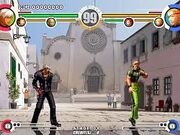
Gameplay of K' vs. Ramon in arcade version
- Temple (Japan): One of the Honganji temples, next to the Shosei-en Garden, in Kyoto. Can be seen panels with a hawk perched on a tree branch and a tiger in a forest, a shinshoku, a dog, people cleaning the floor, sakura trees and a small waterfall.
- Alley (America): A street at night. Can be seen people watching the fight, two bridges, neon signs and graffiti. A motorcycle goes through the stage a few times.
- Ice Festival (Russia): The ice festival of the city of Krasnoyarsk. The fight takes place next to an ice castle. Can be seen ice statues and people filming and throwing snowballs at each other.
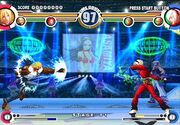
Gameplay of Terry vs. Ash in the PS2 version
- Beach (South America): The surroundings of the Mar del Plata, in the Argentinian province of Buenos Aires. The fight takes next to the beach. Can be seen a mechanical workshop, veichles, palm trees, radios, a tent and people cheering, listening to radios, filming and in sun loungers.
- White Town (Italy): The city of Ostuni. The battle takes in a tunnel next to the cathedral of the city. Can be seen houses, people, posteres with the game's name, the cathedral and some veichles passing, in the background.
- Aqueduct (Spain): The Aqueduct of Segovia. The battle takes in a roof near the building. Can be seen other roofs, the Mirador de la Pradera de San Marcus, in the left, and the Segovia Cathedral, in the background.
Boss Stages
- The Final Hall: A cloudy sky and ruins of a temple. Can be seen lanterns, other temple in the background and destroyed beams, besides flames. Associated with Shion.
- The Different Space: A hideout with beams, a hole with a floating ball and gargoyles. Can be seen a glow coming out of the hole. Associated with Magaki.
- Note:This stage has two versions: in the first, the rocket is launched and it's daylight; in the second, it's night and the rocket returns to the launch base.
- Esaka: Two stages. In the first, the fight takes in the center of Osaka, on a busy avenue. Can be seen people cheering, cars, trucks with the game and SNK Playmore's logo on the carriage, some cameo characters, trees, buildings, traffic cones and a crosswalk. In the second, the battle takes in the front of SNK Playmore's headquarters. Can be seen the company and game's logos, people and cameo characters, trees, scenes of the game and cellphones holograms.
- Wheel (England): The London Eye. The fight takes in one of the domes. Can be seen the Westminster Palace, in the background, and the game's name, in the floor of the dome.
- Note: The only variation is the sunset in one of the versions.
- Concert: A stage. Can be seen a crowd, blue lights, ballerinas with Athena's KOF 2003 costume and a giant screen with artworks of Athena in her original game, in KOF 2000 and in KOF Neowave.
- Note: In another version, the lights are yellow, the ballerinas are gone and several smaller screens with artworks of Athena can be spotted.
Gallery
See also
References
External links
| This page uses Creative Commons Licensed content from Wikipedia (view authors). |










